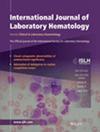Biological Reference Ranges for Healthy Indian Blood Donors: Experience of a Tertiary Care Center Vis-à-Vis International Literature
Abstract
Introduction
Complete blood count is the most common, basic test requisitioned in hematology. The normal reference ranges of hematological parameters are required owing to variable socioeconomic, environmental, and genetic factors in populations. The current study determines the reference ranges of the healthy Indian donor population of a high socioeconomic group.
Methods
The study was conducted in the Department of Transfusion Medicine at a tertiary care hospital in India and included 4098 individuals, aged 18–65 years coming for voluntary blood donation from July 2021 to October 2022. Blood samples were collected in K2EDTA, analyzed on the Sysmex XN-1500 hematology analyzer, and using statistical tools, the normal reference ranges were calculated.
Results
The reference ranges for hemoglobin (HB) (137–185 g/L), WBC (5.1–11.7 × 109/L), platelet count (115.6–370.0 × 109/L) were noted. [Correction added on 22 10 2024, after first online publication: The WBC value has been corrected in this version.] No statistically significant changes were observed in different age groups. There were gender-wise differences noted in nearly all parameters. The HB and hematocrit (HCT) range was slightly higher in other Indian and other Asian populations with comparable values with the Chinese, Korean populations, and Western populations; RBC parameters were overall comparable with minor differences; the WBC count was higher than the other Indian and Asian populations particularly the upper limit of lymphocyte and monocyte; and the range of platelet counts had a comparable upper limit with all populations and had the lowest lower value in males in our study, which was comparable to only the Chinese population.
Conclusions
It is concluded that reference ranges of common parameters were calculated with minor changes noted in all hematological parameters on comparing with other Indian, Asian population, and Western data.

 求助内容:
求助内容: 应助结果提醒方式:
应助结果提醒方式:


